Disclosure: Please note that some links are affiliate links, and at no additional cost to you, we earn a commission if you make a purchase.
If you would like to support this website in some way, using these links will help do exactly that.
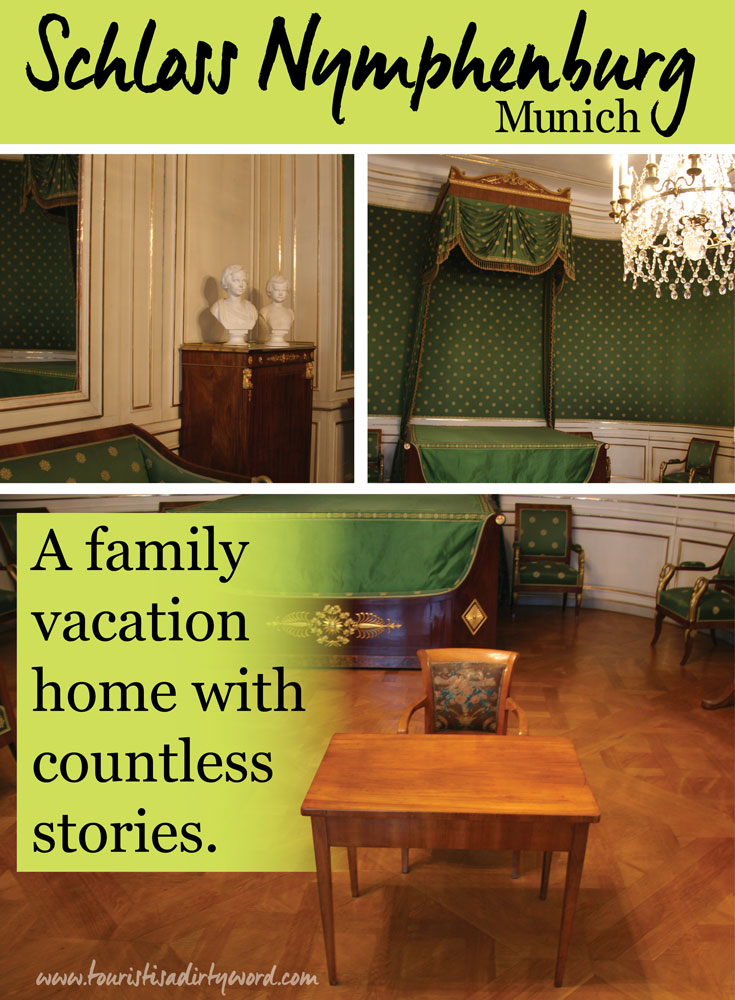
Seeing the tiny, child-size chair and kid's table in the Queen’s room made the palace feel like a home rather than an ongoing museum. That chair and table was once King Ludwig II’s when he was a child. Generation after generation, ultimately this palace, Schloss Nymphenburg, is a family vacation home with many stories to tell.
It was a Sunday morning during Oktoberfest, and we chose to visit Schloss Nymphenburg out of a dizzying array of choices because it felt like it had a little bit of everything; art, history, architecture, and gardens. We had the entire morning to visit the palace and gardens, but to see everything including the pavilion interiors and not be rushed, allow for a full day.
The Great Hall
We entered the Palace through the Great Hall, and the sight of the vaulted ceiling and accompanying gold-gilded stucco work simply took my breath away. When I see such historic, beautiful architecture still existing in person, my eyes tend to water with joy. Yep. I’m that girl, getting all misty-eyed looking at art.
The ceiling was huge, technically two stories since on one side there was a staircase that went up a level to also overlook the hall. I looked at Sebastian, and he knew what was about to happen. I needed to stare at this ceiling, agog in wonder, for a healthy 10 minutes, and take fifty photos or so of various angles before moving on. The stunning ceiling fresco was the work of Johann Baptist Zimmermann, his son Franz Michael, and Martin Heigl between 1755-1757 under Max III Joseph’s rule. The Great Hall has remarkably remained unchanged and preserved as an authentic Rococo room since 1758.

Ten Minutes Later...
We start our way through the wings of the castle, and its immediately ‘choose your own adventure’ as rooms broke off into other rooms and we weren’t sure if we’d end up missing something by accident or going around in circles.
One thing that stood out to me was how often paintings of the palace itself showed up in frames on the wall. It was as if the palace was a family pet that had numerous photos of its antics over the years. The truth is, they needed to constantly paint the palace in order to remember what it looked like. Every generation left their mark on the palace and its design. Many of the furnishings were original or of the time of the palace, often filled with portraits of previous homeowners looking back at you while you’re looking at their belongings and collections.
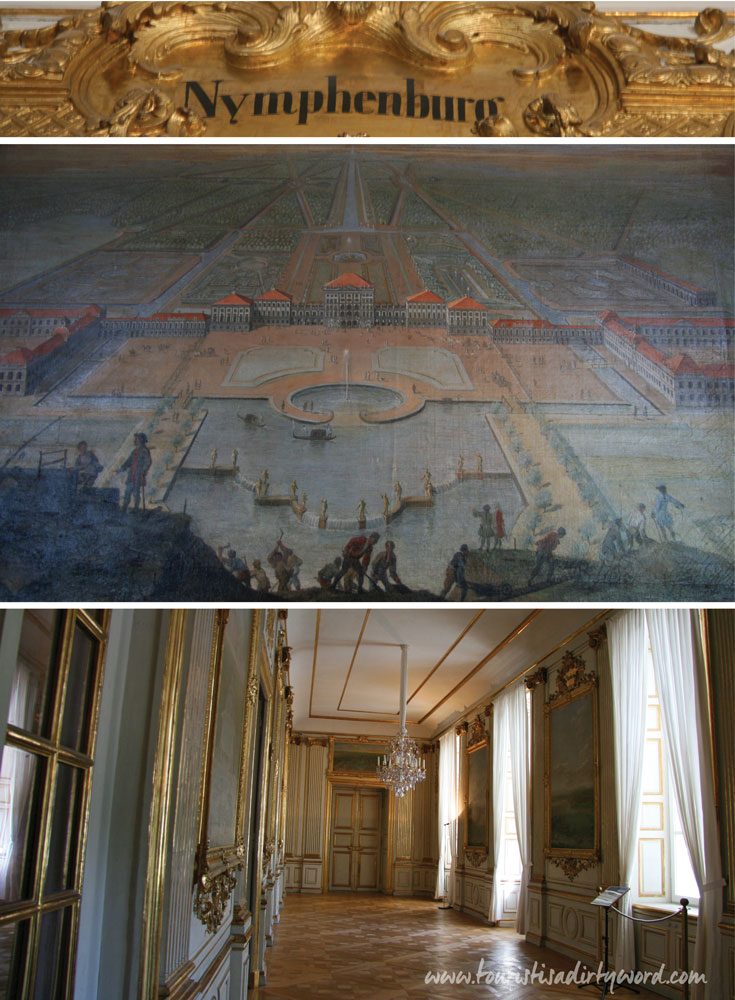

King Ludwig I Gallery of Beauties
When I asked Sebastian what stood out in his memory of the palace, he immediately said the Gallery of Beauties. In the dining room of the Queen’s apartment, the Gallery of Beauties is displayed, a collection of 35 paintings by Joseph Stielier as a commission of King Ludwig I. They were all beautiful ladies, but from all different walks of life, and not necessarily German. The ladies’ wit, personality, and virtue must also be ideal to be included.
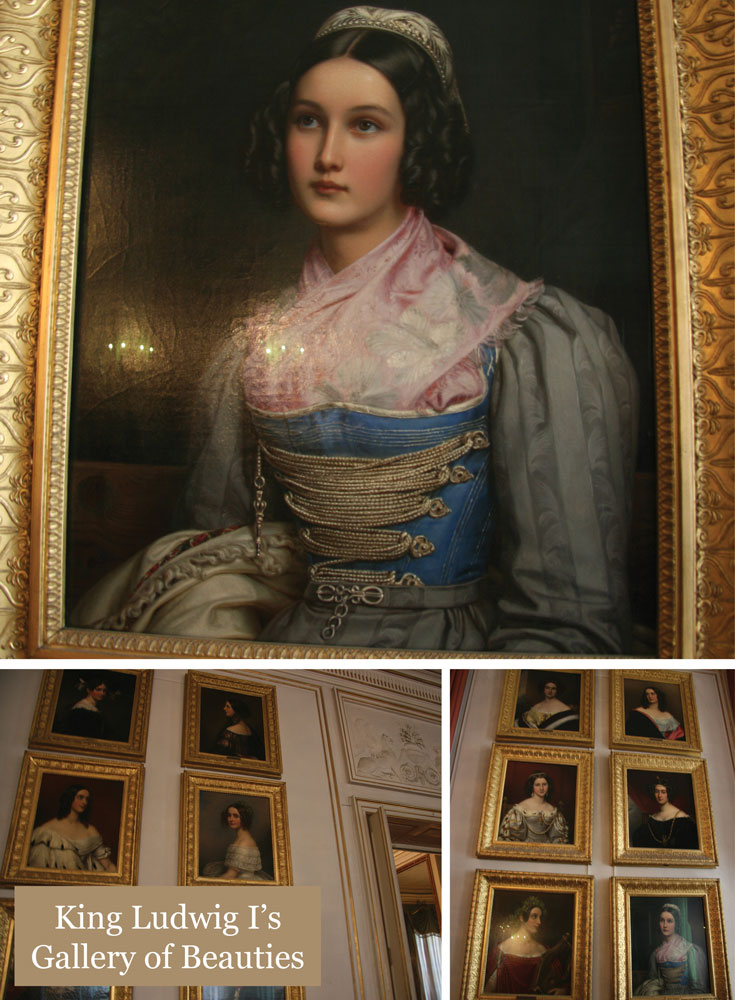
King Ludwig was wholly involved in the project, and out of fourteen ladies nominated by the artist, the King would choose one. His step-mother nominated Elise List, and his wife Therese nominated and convinced Miss Erskine to be a part of the collection. The king would be present during the portrait sittings with Stielier and even direct the outfits. He hand selected and purchased the traditional Bavarian costume for the master shoemaker’s daughter Helene Sedelmayer. Ultimately his friendship with one of his ‘beauties’ would result in his abdication from the throne. If this is interesting for you, I have the perfect book recommendation: King Ludwig I's Gallery of beauties (affiliate link)
It took us several hours to visit all of the accessible rooms in the palace. After concluding our palace visit, we took a leisurely stroll through the park.
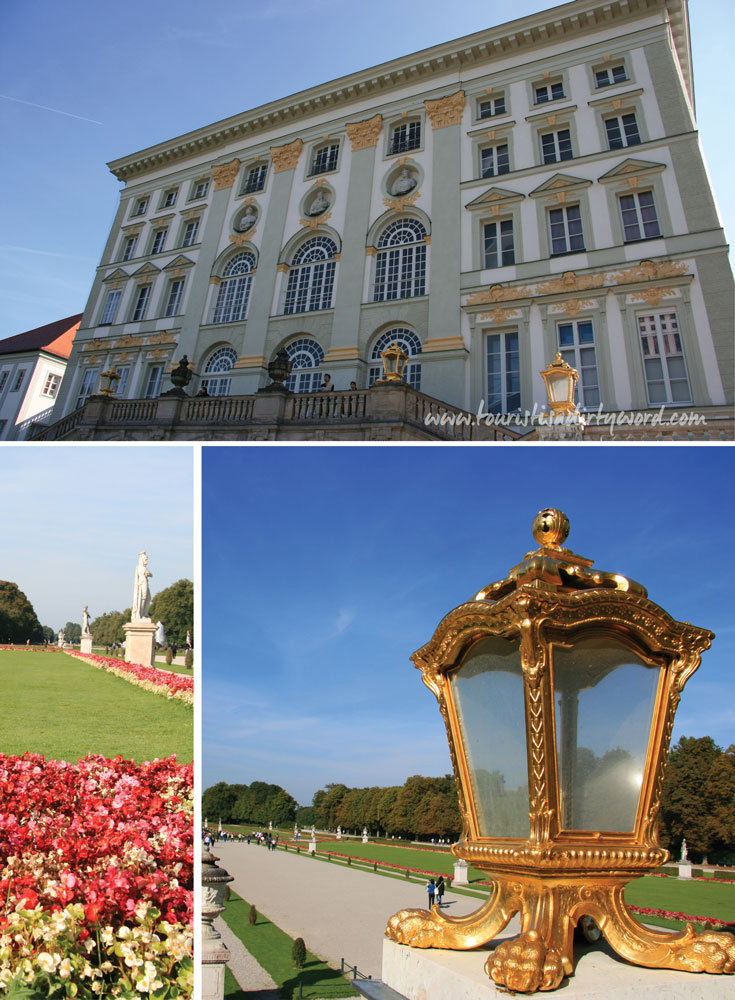
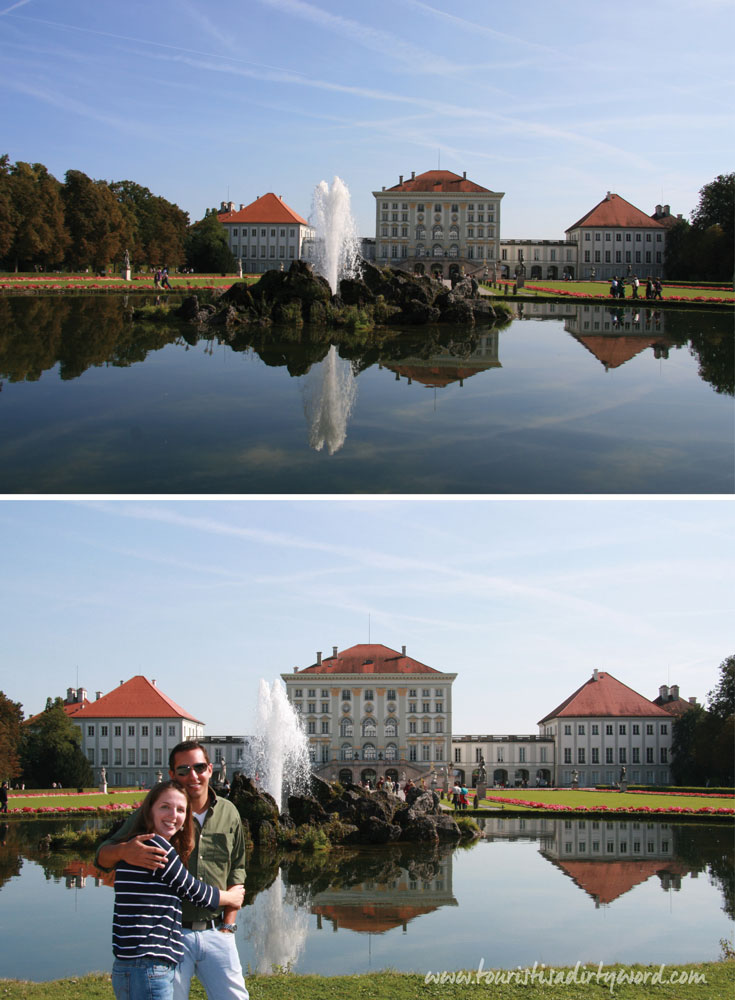
Park Pavilions
Schloss Nymphenburg was the ‘I want to get away from it all’ recluse for the ruler of Bavaria. It was a 2-hour carriage ride from the Munich residence. When you want to escape, reflect, or relax, you’ll need gardens, baths, and sports to unwind with. Over time, the palace grounds provided all of that through numerous pavilions; Amalienburg hunting lodge, the Badenburg bath house, Magdalenenklause for spiritual solace, and Pagodenburg for resting between outdoor games. You’ll need a combination ticket to get inside the pavilions, but to see the outside of them it's part of the public park. We knew we wouldn’t have time to visit inside, but we still wanted to visit the grounds and get an idea how big the park was.
Well, it turns out it's pretty big, and we got lost! Ha! We were trying to hunt down the Monopteros by the lake, and our direct path in our minds turned out to be very roundabout way. We found the Little Village with ‘Green Pump House’ way before we found the picturesque Monopteros. Wear something you can walk comfortably on gravel paths. To explore all of the pavilions you’ll have to walk! To rest up, we had a light lunch Café im Palmenhaus alongside the park before hitting the gift shop for art books on our way out.

Souvenir Recommendations
I chose and whole-heartedly recommend these two:
1. Nymphenburg Palace, Park and Pavilions - Bayerische Schlösserverwaltung. Small but swarthy overview of the building history and room by room descriptions of the objects in each room, including the paintings.
2.King Ludwig I's Gallery of beauties (affiliate link) by Gerhard Hojer which reproduced all 36, including the 1 lost portrait painting, with several essays as well as biographies of each of the ladies. I knew it would have all the details I needed and didn’t have time to read in the exhibit. This book may be best served buying in advance of your trip and reading before you go. The biographies on the ladies’ alone are fascinating.
Follow Along
If you enjoyed this article, or these topics sound interesting to you, you'll love our weekly newsletter. You'll receive a free Germany Packing list for signing up, and you'll receive each week's newest posts every Friday. Thank you for reading!

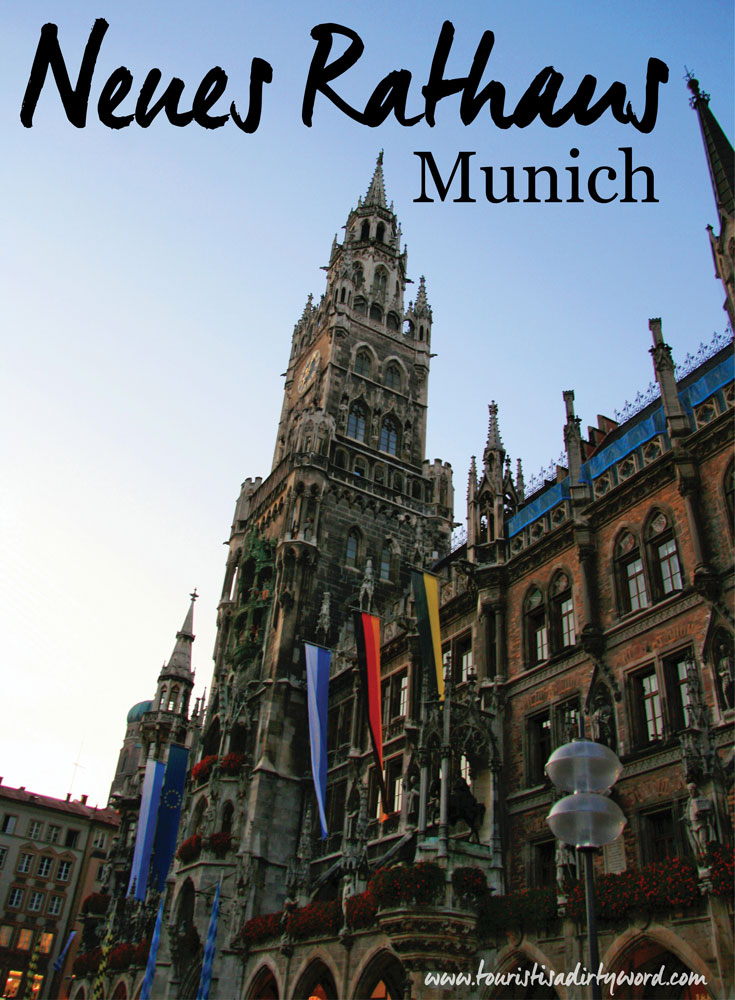
After a full day exploring Oktoberfest, we walked into the old part of Munich. Sensory overloaded from the beautiful costumes and wonderful food of the day, I waddled with my belly full of pretzels, chicken, and beer up this very pointy, church-looking building. The red flowers were shocking amongst the shadowy arcade of windows behind them. When I noticed all of the different flags on the side of the building, I realized it wasn’t a church.
It was the new town hall, Neues Rathaus, where the mayor and city council hold office, and the general headquarters of the Munich city administration. Briefly the memory of our own, gymnasium, institutional-looking city council building back home in Florida shimmers in my mind before dissolving into the beauty before me. It could have been all of the pretzels, but I was confused. Why was this the new town hall, and why did it look so old? And why did it look like a church?
Well, it's complicated, but I’m going to make it super simple..
First, a SUPER basic overview of European architecture (in chronological order) Romanesque to Gothic, to Renaissance, to Gothic Revival.
Romanesque, think sturdy and basic.
Easy way to remember it is the buildings look like sturdy, basic, buildings that could be recreated with preschool wooden building blocks. They got the job done, and didn’t get fancy. [6th century, thereabouts, to late 10th century]
Gothic architects looked at Romanesque buildings and thought, ‘meh, I can do better. Buildings don’t have to be boring.’
Gothic, think skeletal and busy.
Easy way to remember it is the builders wanted to go as high as possible, and let as much light in as possible.
Its easy to go taller if its pointy right? So Gothic has mostly pointy edges.
Want more light? Add more windows. LOTS of windows.
To make the building withstand all the weight now that it's so tall and has tons of windows, it needs more support, but no one wants to LOOK at enormous supporting columns. So they put them outside the building. That’s where the flying buttresses come swooping in to the rescue. Then they didn’t have facebook or instagram to distract them, so they decorated every inch of it. The buildings look visually busy. [12th century in France to 16th century]
Renaissance architects looked at Gothic buildings and thought, ‘Oh my goodness! My eyes are bleeding it’s so busy! Why recreate the wheel, the Greeks and Romans already figured out this stuff, we should just recreate that.’
Renaissance, think columns and geometric.
Easy way to remember it is renaissance sounds like reminisce, as in reminiscing about those old roman/greek glory days.
So here comes the primary school wooden building blocks again. I’ll give them this though, it is a bit more elegant, with a focus on symmetry, decorative columns, and oh-so-pleasing geometric shapes. They cheated a little and used gothic architecture engineering then covered up their tracks with thick, plain walls again. -15th century to 17th century-
Gothic Revival architects looked at Renaissance buildings, then Gothic buildings, then Renaissance buildings again...and thought 'We’re GERMAN. Not Romans, or Greeks! We’re German! We should have German buildings!' I have to mention that Gothic Architecture didn’t actually originate in Germany, it originated in France. Gothic wasn’t POPULAR in France any more! So the Germans thought this was solely their style.
Gothic or Gothic Revival?
The biggest difference between Gothic and Gothic Revival is time, 12th-15th century Gothic, 18th-20th century Gothic Revival. Beyond that, if the stone work looks more uneven, and there are obvious, huge, flying butresses, its likely Gothic. With new building techniques in the 18th-20th century the stones were much smoother and buttresses were not always necessary to support the building's weight.
You just learned how to identify four forms of architecture with a few minutes of reading! Hi-Five! For all my visual learners out there, I took some of my photos of the Munich Neues Rathaus and labeled it with visual clues that its gothic.

Back to the Neues Rathaus in Munich-
Why did the Neues Rathaus in Munich look so old?
Well, although it was built by Georg von Hauberrisser between 1867-1874, which isn’t all that long ago, the popular sentiment at the time believed life was better during medieval times, which had the gothic architecture. This building is part of the Gothic Revival period. They wanted to revive the self-governing glory days of the medieval times and Hanseatic League. It was a close call though. The Munich new town hall was almost Renaissance style. Click here for more about that, and I promise its brief too.
Why did the Neues Rathaus in Munich look like a church?
You know how when there’s a sequel to a movie, usually it's not as memorable as the first one? The first image that pops in my mind when you say Gothic is actually the Notre Dame cathedral in Paris, as well as many other churches. During the 12th and 16th century, when Gothic was born, they only had the time, energy, and motivation to go all out designing churches, and that’s what’s memorable. However, with gothic revival, just like the Neues Rathaus, they started applying that style of design to any type of building, civic buildings included.
Munich simply outgrew their Old Town Hall, which is still standing just around the corner. They even added additional annexes between 1899-1903. For the finishing touch, in 1908 they added a charming glockenspiel to the front facade.
Here are two glockenspiel videos from the Neues Rathaus in Munich, one is for day time, and the other is for night.
Other features worthy of note, there’s over 400 hundred rooms, you can go up to the 255-ft tall observation deck for a fantastic aerial view, and there’s a restaurant dating from 1867 in the basement.
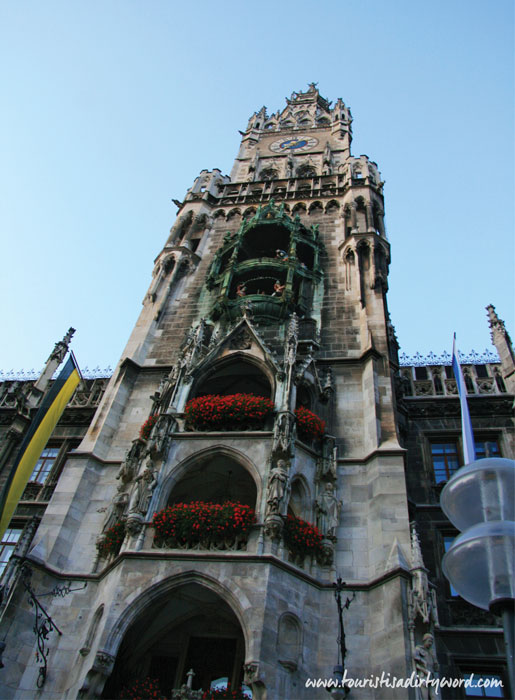
Follow Along
If you enjoyed this article, or these topics sound interesting to you, you'll love our weekly newsletter. You'll receive the newest posts each week and exclusive access to free planning resources like ‘Packing List & Tips for 2 Weeks in Germany’ and ‘Everything You Need to Rent a Car in Germany’.
Thank you for reading!

Bonus Resource: This book, The Gothic Revival by Michael J. Lewis was incredibly helpful in my research on this post about the Neues Rathaus. It's still available for sale on amazon (affiliate link). Chapter 3 was especially insightful on understanding Germany's perspective on the Gothic Revival.
Lewis, Michael J. The Gothic Revival. New York: Thames & Hudson, 2002. Print. Thames & Hudson World of Art.
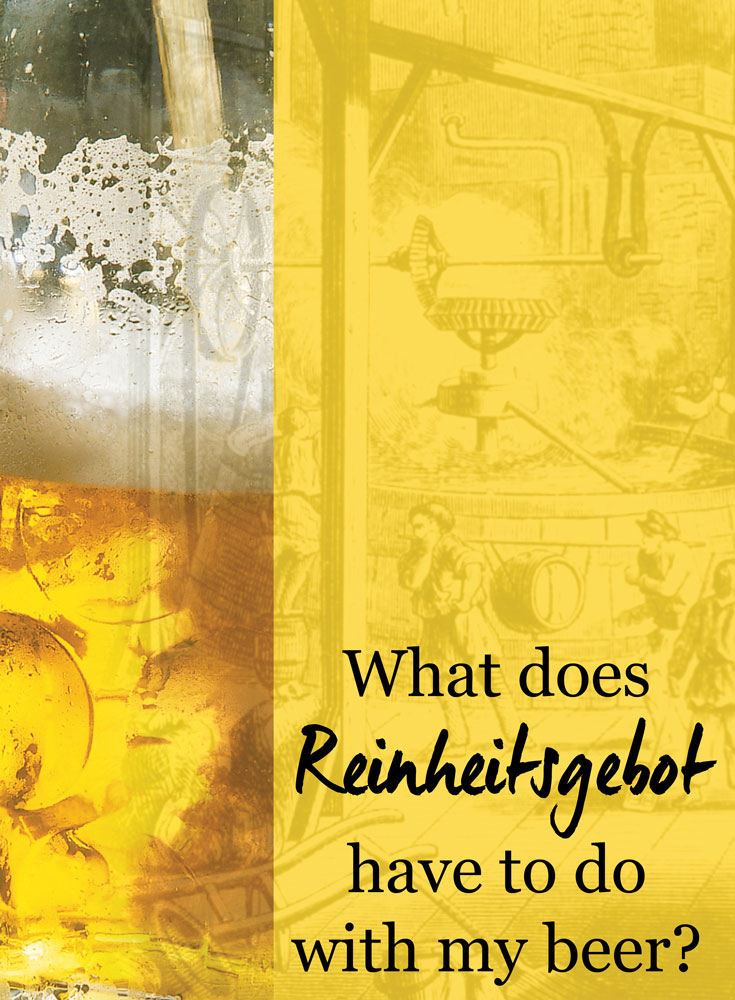
In the 16th century, one beer could be your last.
The Bavarian Duke William IX was justly concerned that beer was frequently contaminated with sawdust and even poisonous plants. He and his brother Duke Ludwig X enacted the famous decree now known as the Reinheitsgebot, the German Beer Purity Law, on April 23rd, 1516 in the Bavarian city of Ingolstadt. The law was introduced as a Landesverordnung (State Act) in Bavaria.
With a regulating purity law in place, citizens would be protected from low-quality and potentially lethal beer. Since water supplies were often polluted at the time, people preferred to drink beer as a safer alternative, thanks to its fermentation process. In honor of its 500 year anniversary this weekend, Denise and I wanted to bring you up to speed!
In 1918 it was called Reinheitsgebot (German Beer Purity Law) for the first time. The purity law requires that, “nothing other than barley, hops and water be used” to produce beer. Yeast was the fourth ingredient added to the purity law, but not until the 19th century when scientists discovered the fermenting agent. After the German unification in 1871, Bavaria demanded the introduction of the law all over the country. The Reinheitsgebot expanded to other parts of Germany in 1906.
How does U.S. beer fit into the law?
The German Beer Purity Law was an early food safety regulation, but there was no equal law ever created in the United States. While the U.S. Food and Drug Administration would never approve a brewer producing an unsafe product, they also do not forbid the use of non-traditional ingredients in beer. Today many American microbreweries and large beer companies experiment with different grains like rice or corn and infuse the beer with coffee beans, honey or different fruits. This progress showed that beer does not have to be a light-yellow, slightly bubbly, bitter-tasting beverage but that it can have a wide variety of flavors while still being a quality beer.
Beer Purity Today
German breweries today continue to use only the four natural ingredients mentioned in the Reinheitsgebot to create over 40 different types of beer, for example Alt beer in Westphalia and the city of Düsseldorf or Kölsch in the city of Cologne area. And while it is legal to import beers into Germany that are brewed with different grains and even treated with chemicals for a longer shelf life, most Germans still take pride in their ‘pure’ beer. And the large beer companies continue to use the slogan that their beer was brewed in accordance with the German Beer Purity Law from 1516 because it serves for a great marketing phrase.
Happy Anniversary Reinheitsgebot!
Have a beer this Saturday to celebrate and let us know in the comments, which German beer is your all-time favorite.
Follow Along
If you enjoyed this article, or these topics sound interesting to you, you'll love our weekly newsletter. You'll receive a free Germany Packing list for signing up, and you'll receive each week's newest posts every Friday. Thank you for reading!
Bonus Resources
• Video If you have 2 minutes and want to learn even more about the German Beer Purity Law, make sure to watch this video from Deutsche Welle TV:
• Listen to the podcast episode "One People, Many Sausages" that mentions the Reinheitsgebot, by BBC Radio 4, Germany: Memories of a Nation
• Read More on the homepage for the 500 year anniversary celebratory page Reinheitsgebot, maintained by the German Brewers Association. We also found the stock images necessary for our Title image collage thanks to them! The source images are shared on their flickr account Brauer-bund with a Creative Commons Attribution-NonCommercial license.
